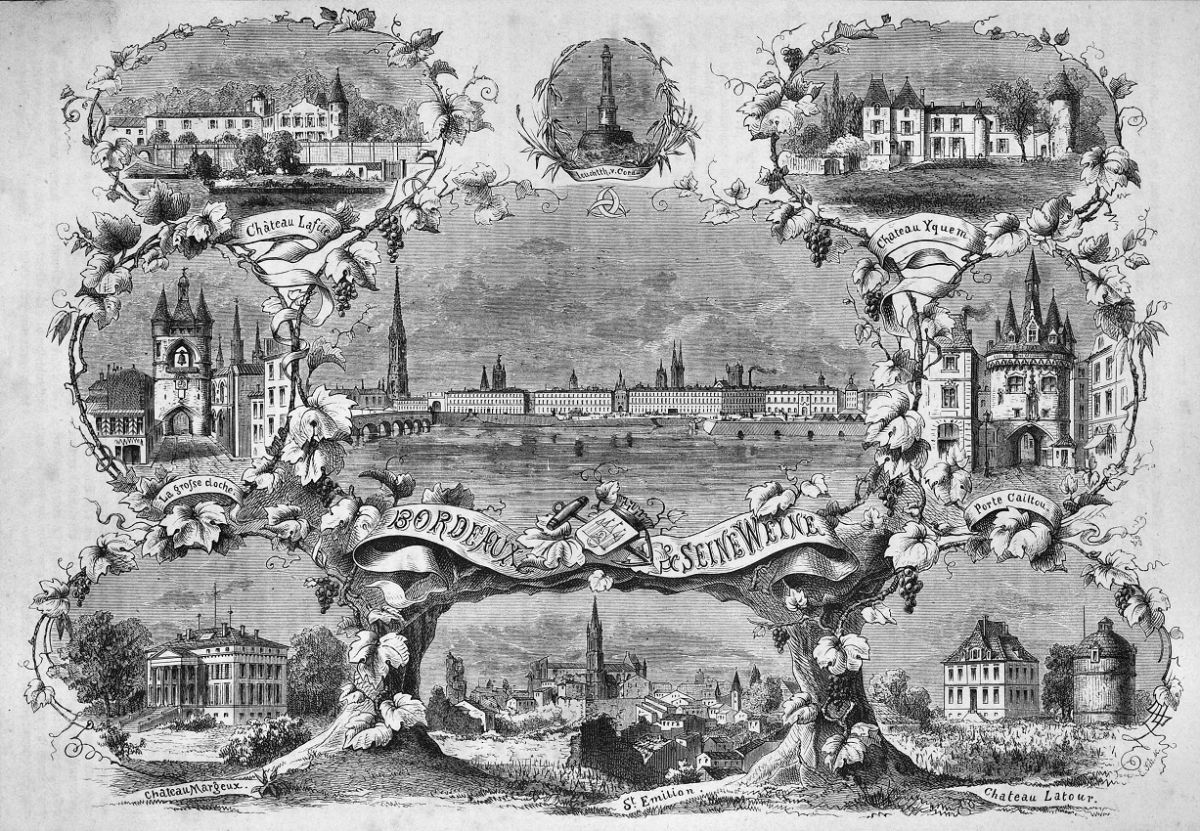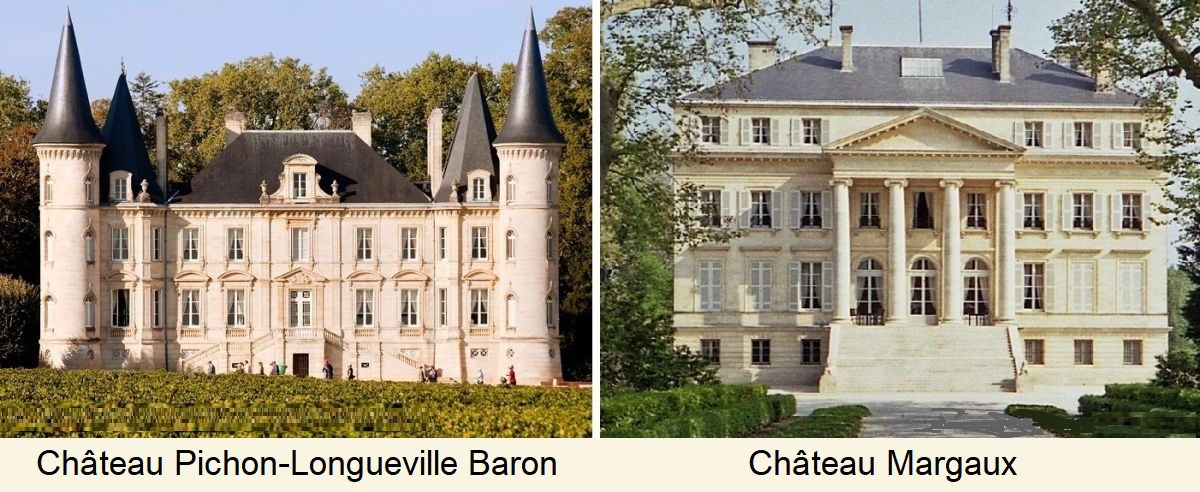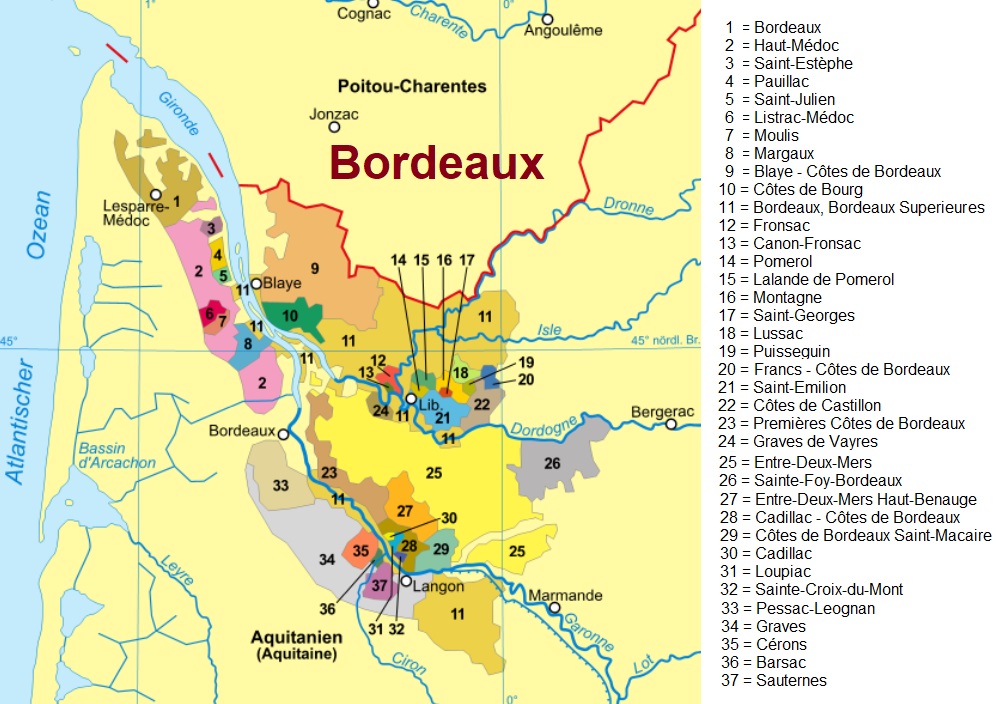Results
2,284 Results
Loading more Results ...
Loading more Results ...
Wine regions in Bordeaux 53 growing regions
Description to Bordeaux
The Bordeaux region is probably one of the most famous wine-growing areas in France and the world. The city of the same name is the capital of the Gironde department with the estuary of the same name in south-west France and is considered one of the most beautiful wine cities in the world. The Greek historian Strabo (63 BC - 28 AD) writes that he found no vineyards when he visited "Burdigala" around 20 AD. However, this is not attested by Pliny the Elder (23-79) a few decades later. This means that the Romans established viticulture here around 50 AD. Bordeaux belonged to England for 300 years (1154-1453) and during this time, viticulture experienced a significant boom due to the wine trade with England and Flanders. This led to the founding of large trading houses and the historically significant Bordeaux wine trade.

The graphic "Bordeaux and its wines" shows 4 famous wine estates classified as Premier Grand Cru Classé in 1855. These are Château Latour, Château Lafite-Rothschild, Château Margaux and Château d'Yquem.
System of origin
From the end of the 17th century, large-scale vine planting began in Bordeaux, particularly in the Médoc. The term "Fureur de planter" (planting fury) was coined for this. This laid the foundation for today's vineyards. Marquis Nicolas-Alexandre de Ségur (1697-1755) was one of the largest vineyard owners. In 1925, the professor of agriculture Joseph Capus (1867-1947) took decisive initiatives regarding the controlled origin system (see Appellation d'Origine Protégée) in France, which led to the founding of the INAO (Institut National des Appellations d'Origine). A term commonly used in the Middle Ages for the entire "Bordeaux hinterland" from Bordeaux upwards along the two rivers Garonne and Dordogne was Haut-Pays.
Bordeaux classification systems
Under the aegis of Emperor Napoleon III (1808-1873), the Universal Exhibition was held in Paris in 1855. The monarch commissioned the Bordeaux Chamber of Commerce to compile a list of the best Bordeaux wines. From a total of 4,000 châteaux, only 61 (60 from the Médoc, 1 from Graves) were deemed worthy. This famous 1855 Bordeaux classification still has great historical significance and promotional value. However, there are 5 other classifications in Bordeaux which, unlike the 1855 classification, are carried out regularly at longer intervals.
Cuvée and barrique ageing
The equation "Bordeaux is French red wine" is appropriate. Typical of Bordeaux are the cuvées, which are not simply referred to as blends, but as assemblages. This has become a standard under the term Bordeaux blend. Each château has its own recipe for blending and vinification, which is carefully guarded. In Bordeaux, barrel ageing in 225-litre barrels has also been used for centuries and barrique ageing has been brought to perfection. This ageing in barrique barrels has become established worldwide.
Climate & soil
The area covers around two thirds of the Gironde department, 105 by 130 kilometres, with a vineyard area of 113,000 hectares. This corresponds to the area under vines in Germany. Only in the south and towards the sea are there no vineyards. The climate, characterised by the nearby Atlantic Ocean with the Gulf Stream and the many rivers, is extremely favourable for viticulture. The summers are not too dry or too hot, the autumn is sunny and the winter is mild and damp. The predominantly barren and stony gravel soil means that the vine roots have to dig ten metres or more into the ground to find water. This makes it easier to survive both dry and rainy periods. The stony soil favours drainage and also serves as a heat reservoir.
Garonne, Dordogne and Gironde
The region is crossed from the south by the Garonne and Dordogne rivers, which join below the city of Bordeaux to form the Gironde estuary, dividing it into two areas in the north. These include the appellations Blaye - Côtes de Bordeaux, Côtes de Bourg, Fronsac, Pomerol and Saint-Émilion(rive droite = right bank) on the right or eastern side of the Gironde and Médoc, Graves and Sauternes(rive gauche = left bank) on the left or western side. The southern part Haut-Médoc is considered the showpiece, the northern part is Bas-Médoc.
Bordeaux blend
There are also significant differences in the grape varieties. However, there are different characteristics of the Bordeaux blend. On the left-hand side, the red wine varieties Cabernet Sauvignon dominate, followed by Merlot and proportions of Cabernet Franc and Petit Verdot. The right-hand side is the domain of Merlot, followed by the white wine varieties Sauvignon Blanc and Sémillon. The two Cabernet varieties contribute the tannins, while Merlot produces softer wines. The three main red varieties account for 90% of the red wine varieties. For white wines, Sémillon is the most important variety with over 50%, followed by Sauvignon Blanc, Colombard, Muscadelle and Ugni Blanc (Trebbiano Toscano).

Châteaux
The importance of viticulture is impressively demonstrated by the fact that wine is produced in over 500 of the 542 municipalities. Around 3,000 wine estates (15,000 in the whole of France) are known as châteaux, regardless of their size, construction or wine quality. Quite a few of these (but not all) actually have château-like buildings. The widely ramified Lurton family empire is the largest owner of wine estates. It produces almost exclusively AOP wines with 65 appellations (98%), and over a quarter of France's wine production comes from here. This makes Bordeaux the world's largest region for quality wines.

Appellations
A large proportion is marketed under the regional appellations. This applies to all AOP wines from the Département of Gironde. They can be a blend of authorised grapes from the entire region. These are Bordeaux (Rouge, Blanc), Bordeaux sec (white wine with residual sugar below 4 g/l), Bordeaux Rosé, Bordeaux Clairet (light-coloured red wine) and Crémant de Bordeaux (sparkling wine). The most successful AOP Bordeaux brand wines are "Dourthe No. 1" from Dourthe-Kressmann, "Sirius" from Sichel, "Michel Lynch" from Château Lynch-Bages, "Maître d'Estournel" from Château Cos d'Estournel and the top seller and global export hit Mouton Cadet from Château Mouton-Rothschild.
- Atlantique (IGP)
- Blaye
- Blaye - Côtes de Bordeaux - formerly Blaye or Premières Côtes de Blaye
- Bordeaux Clairet
- Cadillac- Côtes de Bordeaux, Cadillac
- Castillon - Côtes de Bordeaux - formerly Côtes de Castillon
- Cérons
- Côtes de Blaye
- Côtes de Bordeaux, Blaye, Cadillac, Castillon, Francs
- Côtes de Bordeaux Saint-Macaire
- Côtes de Bourg - also Bourg or Bourgeais
- Crémant de Bordeaux
- Entre-deux-Mers, Entre-deux-Mers Haut-Benauge
- Francs - Côtes de Bordeaux - formerly Bordeaux Côtes de Francs
- Fronsac Canon-Fronsac, Côtes Canon-Fronsac
- Graves, Graves Supérieures
- Graves de Vayres
- Haut-Médoc, Listrac-Médoc, Margaux, Moulis, Pauillac, St-Estèphe, St-Julien
- Lalande de Pomerol
- Loupiac
- Médoc
- Néac
- Pessac-Léognan - formerly Haut-Graves
- Pomerol
- Premières Côtes de Bordeaux
- Sainte-Croix-du-Mont
- Sainte-Foy-Bordeaux
- Saint-Émilion, Montagne, Lussac, Puisseguin, St-Georges
- Sauternes, Barsac, Sauternes-Barsac

Drawing: Par divers - Domaine public, Lien
Grape varieties: Ursula Brühl, Doris Schneider, Julius Kühn-Institut (JKI)
Map: By Domenico-de-ga from Wikipedia, CC BY-SA 3.0, Link
Classified wine producers in Bordeaux 224
find+buy for Bordeaux 83
Recent wines 1149
 Domaine Uchida
— Bordeaux
2022 Haut-Médoc AOC Cuvée "Rosa"
54.00 €
Domaine Uchida
— Bordeaux
2022 Haut-Médoc AOC Cuvée "Rosa"
54.00 €

 Château La Louvière
— Bordeaux
1995 Pessac-Leognan AOC
Château La Louvière
— Bordeaux
1995 Pessac-Leognan AOC

The most important grape varieties
More information in the magazine
- Dark clouds over Bordeaux Liv-ex: Prices for 2023 have not fallen low enough
- Good Bordeaux doesn't have to be expensive! Crus Bourgeois
- Liv-ex Power 100: Bordeaux The number of brands in the top 100 has fallen to a new low
- Château Léoville Barton Saint Julien, 1997 Bordeaux, France
- Château Latour à Pomerol Latour à Pomerol 1981, Pomerol, Bordeaux, France
- Château Pichon Longueville Baron Les Tourelles de Longueville 1996, Pauillac, Bordeaux, France
- Château Beychevelle Beychevelle 2000, Saint Julien, Bordeaux, France
- Châteaux Ausone Ausone 1997, Saint-Emilion Grand Cru, Bordeaux
- Château Léoville Poyferré Saint Julien, 1997, Bordeaux
- Château de Monbousquet Angélique de Monbousquet 2008, Saint Emilion, Bordeaux

